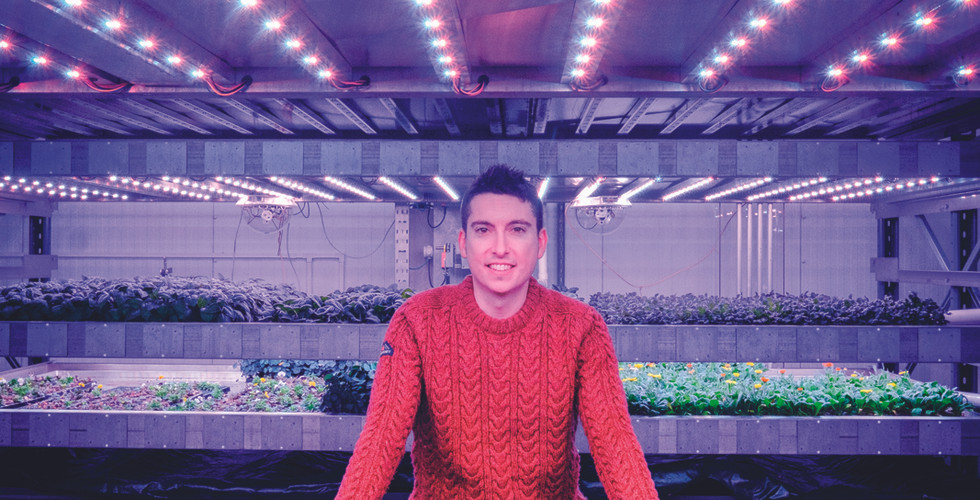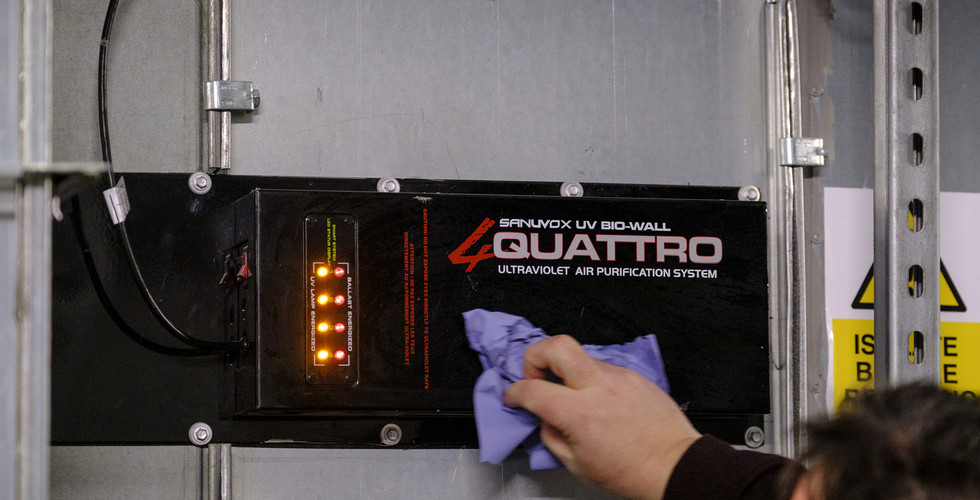The only way is up
- Tim Power
- Apr 11, 2022
- 8 min read
SELECT Member James Boak is helping agriculture pioneer Dave Scott change the way we grow our food through LEDs and vertical farming

James Boak has had some interesting experiences throughout his electrical career: from fitting out luxury villas in St Lucia with low-energy technology and power surge protection equipment to installing a pioneering battery storage system in a power station in the Shetland Islands.
However, when he was asked by Dave Scott, the co-founder and Chief Technology Officer of Intelligent Growth Solutions (IGS), for help to design the completed electrical system for a ‘vertical farm’ nine years ago, it was an exciting challenge.
James, Managing Director of Roslin-based JBE Scotland Ltd, explained his surprise: “I knew Dave from my time as an electrical contractor with the large retailer where he managed the automated tower storage systems in their warehouses. When he contacted me about designing the electrical system for a vertical farm – or growth tower, as IGS calls it – it was the very first time I had ever heard of the concept, so I was intrigued.”
Vertical farming is the practice of growing young plants in vertically stacked layers of trays in buildings where the environment is carefully controlled and the life-giving sun is replaced with LED lighting, which can be altered to provide a range of wavelengths depending on the growth strategies for different crops. By effectively controlling the growing process – manipulating the lighting, internal climate, irrigation and nutrient supply – vertical farms can operate all year round.
Key to the success of the vertical farm system is the ability to control light frequencies, via the LEDs, so a stability electricity supply is vital.
James explained: “In this context, it was important that I was able to manage the characteristics of the electrical and lighting systems in the IGS growth towers as we were concerned about potential fluctuations in power supply affecting the sensitive electrical equipment in the towers – we had to keep the harmonics very low and voltage as stable as possible.”
Although Dave’s expertise is in engineering, he originally trained as an electrical engineer and values the SELECT courses he often attends to keep up to date with developments in the electrical industry.
He drew heavily on this background to bring the IGS concept to life, but needed James’s considerable experience in electrical engineering, particularly in building and maintaining bespoke projects focused on energy-efficient and stable electrical systems.
James said that he and Dave worked on the design concept for the IGS growth towers – a central work area surrounded by four crop towers within a large rectangular building – for about a year, ensuring that the overall design was scalable, so it was flexible enough to accommodate expansion in the building.
To ensure stability in power supply, James’s design included bringing in a new connection from the grid via a dedicated substation with new sub mains cabling into the towers and then distributed through a Schneider Electric distribution panel located in the entrance to the building.
The entrance is also protected by an airlock to ensure that the environment within the growing tower is kept as sterile as possible.
Dave was keen that the growth tower use a three-phase power supply to make the most efficient use of the LEDs, as he explained: “LED technology is key to the growth tower’s success. The whole system is focused on light and the control of this light.
“To do this effectively, it was not only important to use the latest LED technology but to also power the system through a three-phase electrical supply to give us the most stable harmonics.
“To solve the problems of appropriate light intensity and light pulse width modulation (PWM), we developed a patented three-phase technology for LED lights that varies intensity and PWM infinitely in 0.01% increments over all wavelengths simultaneously.
“This platform achieves this while maintaining a 90%+ electrical efficiency from the power source to LEDs.
“By bringing the initial 400v down to 50v through a transformer, we hit the most efficient and sustainable way of running LED strings and it also means that we can safely position naked busbars to power the equipment within the towers.”
James designed the full electrical installation and control room in a central raised mezzanine area next to the plant room for the four towers. This also hosts the water irrigation system and nutrient supply, as well as the air conditioning system that collects all the water that is lost through evaporation and transpiration – plants lose water through their leaves – and recycles it.
James added: “Another key aspect of the design was giving IGS the facility to grow or move equipment easily; that’s why we have used SY cable and FP2000 instead of SWA armoured cables, as the SY cable gives us the ability to move things around, particularly in a clean environment, as long as we can achieve mechanical protection.”
In addition to the design of the lighting and power system, ventilation, air conditioning, fire alarms and other emergency back-up safety systems, James also had to factor in an aircraft warning system on top of the growth tower as the facility is near Dundee Airport.
The first IGS growth tower was built in St Andrews, and this proved the design concept and helped to raise funds to build a larger-scale tower in Dundee on the site of the James Hutton Institute – the globally recognised research organisation focused on the sustainable use of land and natural resources.
Here, the IGS crop science team works in partnership with the Hutton’s scientists on crop trials to understand how plants growing in the towers react to variations in light, temperature and different nutrient recipes, while the IGS team experiments on product hardware and software testing.
IGS’s Crop Research Centre – the first vertical farm in Scotland when it launched in 2018 – is based on a nine-metre-high building that consists of four towers, each on the footprint of 42 square metres, based around a central work area.
Each tower can accommodate 50 stacked growth trays – the size of a snooker table – which can be accessed for planting, monitoring or harvesting, as well as being moved to different heights within the tower by an automated central lift mechanism.
Each tray is illuminated by ventilated LED light strips from the base of the tray above it – approximately 1,100 LEDs per tray – and smart technology manages luminescence and light spectrum, air temperature, humidity, irrigation and nutrient supply for the crop in each tray. This allows for different crops to be grown in close proximity to each other, resulting in crop growth that is 30-50% faster than traditional methods.
Typical crops include leafy greens, herbs such as basil, coriander, oregano and mint, as well as salad leaves and microgreens, but IGS is experimenting with other crops, such as seed potatoes, strawberries and flowers that are used as botanicals for the flavour and fragrance industry.
The IGS vertical farm system requires no pesticides and it is designed to be energy-efficient and to recycle all the water from its closed system so it has a minimal environmental impact.
That’s why this system is ideal for areas where water is limited, as well as for cities, as the guaranteed crop yields mean that IGS farms can provide ‘quick to market’ locally grown fruit and vegetables with minimal transport costs.
James has been involved with IGS from the beginning as a consultant, and then as a contractor, and has witnessed the company grow from five engineers over the nine years to a team of 150, including a team of software engineers who develop crop-specific growth management systems for each tower specific to customers’ needs.
He said: “My career has been very diverse, including owning a building services company for more than 25 years, installing the first battery storage facility in the Shetland Isles and introducing voltage stabilisers, optimisers and power factor correction onto the island of St Lucia.
“IGS has provided a wonderful opportunity for me to learn about this new type of industry.
“It’s been a rewarding experience and one that I think few electrical contractors have experience of today.”
High ambitions to grow quality produce
Dave Scott, Intelligent Growth Solutions (IGS) co-founder and Chief Technology Officer, likes to describe the IGS growth tower as a very large vending machine for crops. But behind this levity is a serious aim to create a new system of producing high-quality food in a sustainable way.
He has designed the growth towers to be as energy efficient and simple to manage and monitor as possible – most of the crop management can be controlled remotely off-site – but just as important is the ability to easily expand the towers into multiple interconnected units. This scalability will give the economies of scale that large food-producing customers are looking for.
IGS is not a food producer; it is a ‘tech vendor’ that has designed a growing system for others to use. It provides not only the superstructure and operating system of the growth tower but also specific growth ‘recipes’ for each crop, which include LED light frequencies, environment regimes and irrigation and nutrient inputs. That is why its in-house team of crop scientists and its strategic partnership with the James Hutton Institute is key to future development.
Dave said: “There is an enormous amount that we’re still learning about plants and how they develop. We are creating unique microclimates and growing regimes for each crop to grow as efficiently as possible, but sometimes certain plants benefit from being stressed in their early growth period to develop better resilience to outside conditions later on, and this can be achieved by pulsing lights under different frequencies.
“We can even know how plants are ‘feeling’ from the frequency of light they project back, whether they are relatively ‘happy’ or ‘stressed’ – it has really captured my imagination.
“There are so many variables to play with so that is why we carry out trials at our Crop Research Centre, both for our own R&D, in conjunction with customers, and in partnership with the James Hutton Institute to learn more about this system of growing plants, and to help to develop ‘recipes’ for our customers to use in our system for the optimum way to grow selected plants.”
The most common crops grown in vertical farms are quick growing, fast harvesting, high-value plants such as micro herbs for restaurants and larger herbs like basil for supermarkets and food manufactures. However, IGS is also experimenting with crops including chillies, strawberry seedlings, brassicas, seed potatoes, flowers and even trees: IGS trials with fir tree saplings have reduced the time they are ready for planting out by one third.
The market for vertical farm technology is set to grow – business intelligence firm IDTechEX forecasts a global market value of $1.5 billion for vertically farmed produce by 2030 – and IGS is already seeing the fruits of such growth, as it is picking up new customers across the globe.
It has recently signed up French company Jungle in a multi-million-pound deal where it will use vertical growth towers to supply crops to its retailers on an industrial scale, and has a contract with another international company, Therme Group, to use IGS technology to grow fresh produce on urban farms within its wellbeing centres across Europe and skincare products. There are also new clients in Germany, the USA and Australia and, in late 2021, IGS secured a further £42.2 million from international investors, showing that there are high levels of investor confidence in the future of vertical farming.
THE SELECT VERDICT
By Darren Sweeney, Technical Adviser

Late arrivals at SELECT training courses can often be frustrating, but when Dave apologised for his tardiness because he’d just flown in from the USA, it was only polite to ask the reason for his visit across the pond.
Further discussions revealed the technology involved and, with our interest duly piqued, a visit to JBE was arranged to see the project first-hand, with James showing off his handiwork.
It was immediately apparent that this was innovative work that deserved a wider audience and which fellow SELECT Member firms would find interesting.
The whole project – from the LED lighting rigs to the environmental controls and managing efficiencies – is full of elements that all electricians need to integrate successfully with other services, especially in this case where Dave and James were overcoming issues in a new field (quite literally).
The whole project was really impressive and I wish them both continued success.










































































Comments